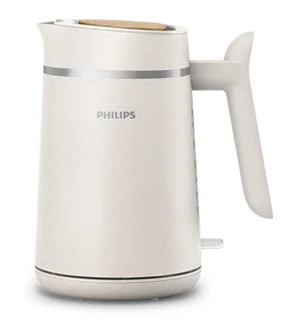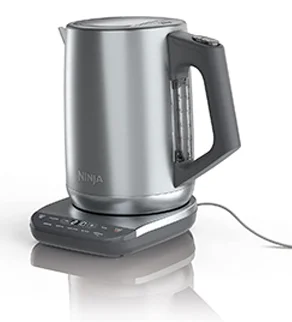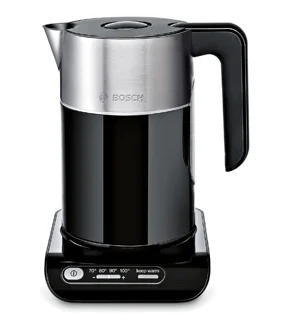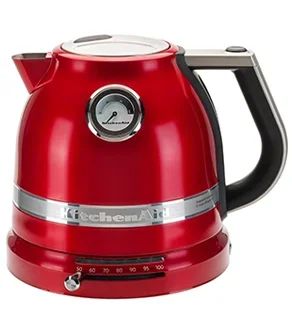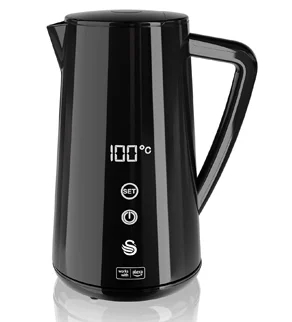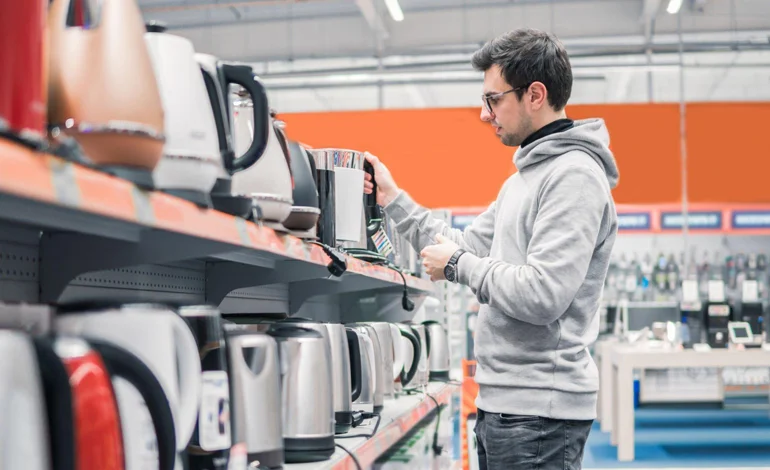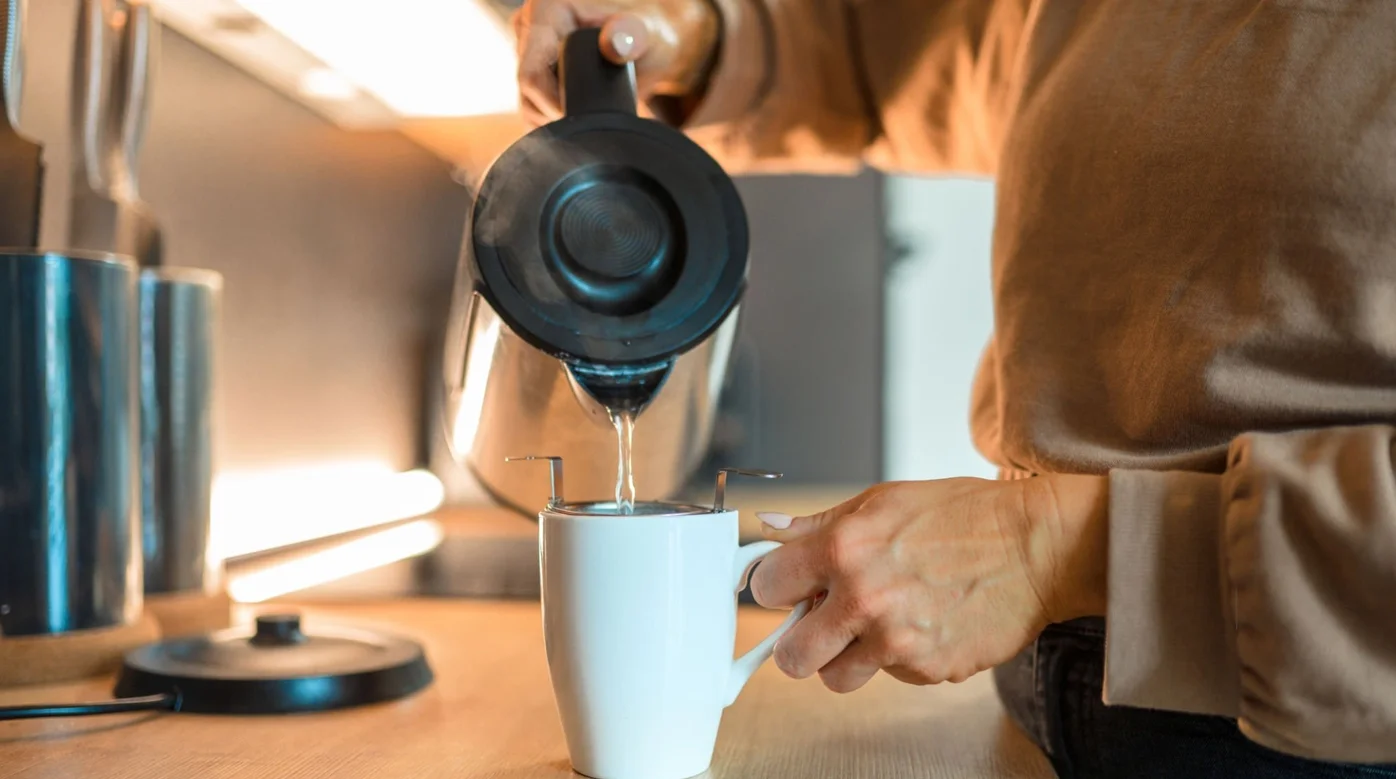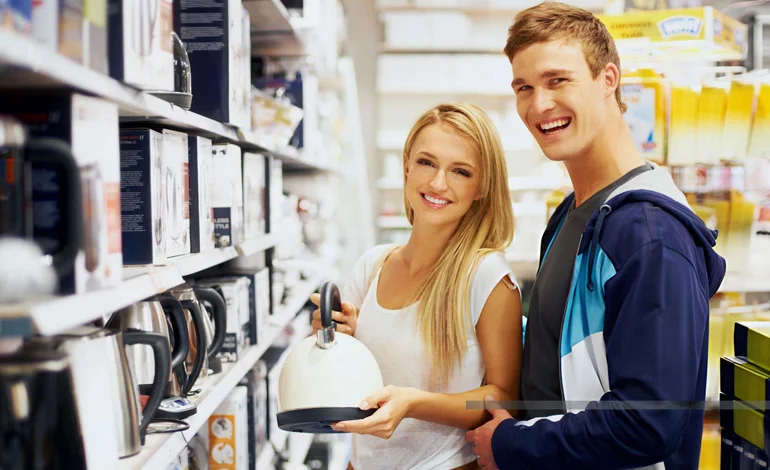5 Best Energy Efficient Electric Kettles in the UK 2025
Energy costs are on everyone’s minds, and with a growing desire to live more sustainably, the appliances we choose for our homes matter more than ever. Take the standard electric kettle, for example. It’s a kitchen pivotal that’s often used multiple times a day. Over time, even small imperfections can lead to a significant increase in your electricity bill and have a big impact on the environment due to every home’s use across the UK. So choosing an energy-efficient electric kettle in 2025 is not only a good idea – it’s a smart move for your wallet and the planet.
The beauty of energy-efficient kettles lies in their dual benefits. Firstly, they’re designed to use up electricity slowly but surely rather than gobble it up, which simply means savings on your energy bills. Secondly, by using less electricity, they help reduce the overall demand on energy resources, which in turn reduces the environmental impact of electricity production.
This win-win scenario makes them an attractive option for those who want to make purchasing decisions that suit both their budget and their values. As we head towards 2025, the market is full of kettles that not only boast impressive energy-saving features but also look great and perform superbly. Finding a kettle that ticks all the boxes – smart, stylish and durable – has never been easier. This guide will show you the five best energy-saving electric kettles you could find in the UK in 2025, including what makes them stand out.
- More info
- Less info
Why You Should Get It?
Go green and stylish! This kettle uses bio-based plastics for a lower footprint and looks great. Plus, boil just one cup to save energy and money!
Keep In Mind Before Buying:
While super sustainable and stylish, our reviews suggest it might not be the most energy-efficient overall. Also, check if rapid boil is a must-have for you!
If you are someone who values environmental responsibility without sacrificing energy efficiency, then the Philips Eco Conscious Edition 5000 Series Kettle is worth your time. What makes it particularly eco-friendly is that it uses 100% bio-based plastic. The sustainable materials significantly reduce the kettle’s carbon footprint during use, which is a big plus for eco-conscious consumers.
Apart from its green credentials, this kettle has a number of features designed to reduce energy waste during use. It has a clearly marked water level indicator, including a handy one-cup marking. Its simple yet effective design encourages you to boil only as much water as you need, thereby tackling the common problem of overfilling and wasting energy. For added safety and even more energy savings, the kettle automatically switches off when the water reaches boiling point or when you lift it from its base. Plus, a concealed stainless steel heating element ensures faster boiling and makes cleaning a breeze.
The Philips Eco Conscious Edition 5000 Series Kettle has a lot to offer. It uses sustainable materials that match perfectly with the growing demand for eco-friendly products. It also has a sleek and minimalist design, often compared to Scandi aesthetics, making this kettle a stylish addition to any kitchen. Lightweight and easy to handle, this is a cordless kettle with a practical 360-degree pirouette base for effortless use from any angle.
However, other reviews we have found suggest that it may not be the best performer in terms of operational energy consumption compared to some of its rivals. Also, this kettle doesn’t boil fast for less energy consumption, which might be a consideration if boiling speed is a priority for you. You can find this kettle from major UK retailers such as Amazon and directly from Philips UK.
Key specifications:
- Material: Plastic
- Colour options: Silk White
- Window for water level: Yes
- Capacity: 1.7 litre
- Keep-warm or auto shut-off feature: Auto shut-off
- Temperature control: No
- More info
- Less info
Why You Should Get It?
Master your brew! Precise temperature control, rapid boil, and “Hold Temp” save time and energy for perfect drinks every time. Super versatile!
Keep In Mind Before Buying:
It can be a bit noisy when boiling. The design is functional, not fancy. Water level light only comes on when you press a button.
For those who want to have precise control over their hot drinks and save energy through clever features, the Ninja Precision Temperature Kettle is also a serious contender. One of the standout energy-saving features of this kettle is its six pre-set temperature settings, ranging from 60°C to boiling at 100°C.
This kettle also has the option to manually adjust the temperature in precise 5°C increments. This level of temperature control is crucial for energy efficiency in this kettle, as different drinks, such as delicate green tea or rich coffee, taste best at specific temperatures and don’t always require boiling water. You choose the exact temperature you need while also saving energy by avoiding unnecessarily overboiling the water.
The Ninja KT200 Precision Temperature Kettle also has a fast boil function, so you can get hot water instantly when you’re short on time. Although rapid boiling can be energy-intensive, it can also actually save energy overall if you’re only boiling the exact amount of water you need for immediate use.
Plus, the kettle’s Hold Temp function is a fantastic energy-saving feature, which keeps your water at the temperature you’ve selected for up to 30 minutes. This means you don’t have to boil as many times if you’re making multiple cups, which is great for busy and larger households. To further reduce energy consumption, this kettle automatically goes into sleep mode after five minutes of inactivity with the help of the digital control panel, which handles standby power usage.
The Ninja Precision Temperature Kettle is incredibly versatile; with its 1.7L capacity, it’s ideal for both personal use and serving a crowd.
We found in our test that it’s a little noisy when boiling. The sleek matte black finish, while stylish, does show fingerprints. Also, a minor quibble is that the water level display only lights up when you press the button, which we found less convenient for a quick glance.
Key specifications:
- Material: Stainless-steel
- Colour options: Stainless-steel
- Window for water level: Yes
- Capacity: 1.7 litre
- Keep-warm or auto shut-off feature: Both
- Temperature control: Yes
- More info
- Less info
Why You Should Get It?
Get the Bosch Styline! Variable temps and KeepWarm mean perfect drinks and energy savings. Boils fast, looks stylish, and stays cool outside!
Keep In Mind Before Buying:
Just know it can be a bit noisy! The temperature display is only on the base. In our testing, we found few users reported leaks after a couple of years, so check reviews.
The Bosch Styline Kettle TWK8633GB offers a reliable combination of performance and energy-saving features, making it a popular choice in many UK kitchens.
The kettle’s energy efficiency is thanks to its four different temperature settings – 70°C, 80°C, 90°C and 100°C – which are clearly displayed on its base with an LED indicator. Like the Ninja Kettle, Bosch’s variable temperature control lets you heat water to the perfect temperature for your drinks, avoiding wasting energy boiling more water than necessary.
Its energy-saving efforts also include a KeepWarm function, which effectively maintains your chosen water temperature for up to 30 minutes. The keep warms function is especially useful when you or your family want to enjoy several hot drinks in a short period of time, as it reduces the need to boil water repeatedly, thereby saving energy.
The Bosch Styline Kettle has a double-walled housing made of stainless steel. This feature also helps keep boiled water hot for longer. The double wall of the kettle also ensures that the exterior of the kettle remains cool to the touch, increasing safety for you and your family.
We found in our test of the Bosch Styline Kettle that it gives you the benefit of variable temperature settings to meet the specific needs of different beverages. It boils water for you quickly, with a powerful 3000W element, and the cool-touch adds a layer of protection to keep your hands safe. This kettle also boasts a stylish look that comes in a variety of colours to complement your kitchen.
However, we also noted that it was a bit noisy when boiling. Unlike some other models, the temperature settings are only visible on the base, not on the kettle itself. We find its potential leaks and long-term build quality to be an issue.
Key specifications:
- Material: Stainless-steel, Plastic
- Colour options: Black, White
- Window for water level: Yes
- Capacity: 1.5 litre
- Keep-warm or auto shut-off feature: Both
- Temperature control: Yes
- More info
- Less info
Why You Should Get It?
Love iconic style? This premium kettle offers variable temps, quiet boiling, and dual-wall insulation to keep water hot longer for perfect drinks!
Keep In Mind Before Buying:
It’s a significant investment! Also, it can feel heavy when full, and one review noted it wasn’t the most energy-efficient in their testing.
For those willing to invest in a premium appliance that also has an iconic retro design along with energy-saving features, we find the KitchenAid Artisan Kettle 2025 to be a top contender. Prioritizing energy-saving, its double-wall construction effectively traps heat inside. This helps water stay hot for longer and reduces the need to boil it as often, saving electricity. Its passive insulation also helps maintain water temperature without using additional electricity.
In addition, the KitchenAid Artisan Kettle has a temperature gauge on its base. This allows you to see the current temperature of the water and boil it to the appropriate degree as needed, also saving a lot of energy.
This model also offers variable temperature settings, ranging from 50, 60, 70, 80, 90, 95, and 100 degrees Celsius. It gives you precise control to optimize energy use, as certain beverages taste best at specific temperatures. Additionally, this model includes a keep-warm function that can maintain the desired water temperature for up to 30 minutes, saving you the energy required to boil water repeatedly.
The elegant look of the KitchenAid Artisan Kettle comes in a wide range of colors to suit any style kitchen. We appreciate its quiet operation when boiling, and its easy-to-use controls.
However, this kettle comes at a significantly higher price than many other kettles. In our opinion, this KitchenAid kettle may be too expensive for budget-conscious buyers, even considering its common energy-saving features.
We found it quite heavy during use, especially when it’s filled to its 1.5L capacity. Interestingly, it wasn’t found to be energy-efficient in our testing, despite its double wall. This shows that all features designed to save energy don’t always guarantee top-level efficiency in all areas of operation.
Key specifications:
- Material: Stainless steel
- Colour options: Almond Cream, Candy Apple, Cast Iron Black, Medallion Silver, Onyx Black, Pebbled Palm
- Window for water level: Yes
- Capacity: 1.5 litre
- Keep-warm or auto shut-off feature: Both
- Temperature control: Yes
- More info
- Less info
Why You Should Get It?
Control it with your voice or phone! Variable temps and a long keep-warm save energy and make perfect drinks, plus it looks great!
Keep In Mind Before Buying:
It’s pricier, and the beeps can be annoying. No water window, and boiling small amounts or standby mode might use more energy.
For those who are embracing the smart home technology of the AI era and want an energy-efficient kettle, the Swan Alexa 1.5 Litre Smart Kettle SK14650BLKN is an innovative solution. The kettle has a stylish modern design that complements the contemporary kitchen.
The advantage of this kettle is that you can control it remotely using Alexa voice commands or a dedicated smartphone app. This smart control gives you full control over the kettle so that water boils only when you need it. With the help of the control app, you can prevent the kettle from being on unnecessarily, which reduces potential energy waste.
The Swan Alexa Smart Kettle also offers you variable temperature settings ranging from 40°C to 100°C. Its temperature settings can be accessed via the touch display or the companion app. This feature lets you choose the exact temperature for different beverages, ensuring that the water doesn’t overboil, which helps save energy.
Additionally, it also has a keep-warm function that can keep water at the selected temperature for up to two hours. Although using the keep-warm function for a long time will consume some energy, you don’t have to boil small quantities of water frequently.
The scheduling feature of this kettle also allows you to set specific times for water to boil automatically, which further improves your energy management. With this, you can prepare hot water in your daily routine without manual operation and also optimise energy use.
However, the Swan Alexa is a smart kitchen appliance, which is more expensive than a traditional kettle. In testing, we found the beeping sound it emits to be a bit annoying. It also lacks a transparent water level window, which makes it easy to check the water level at a glance. Additionally, its boiling process is relatively slow compared to cheaper kettles with higher wattage.
Key specifications:
- Material: Stainless-steel
- Colour options: Black
- Window for water level: Yes
- Capacity: 1.5 litre
- Keep-warm or auto shut-off feature: Both
- Temperature control: Yes
What makes an electric kettle energy efficient?
When you’re looking for an energy-efficient kettle, there are several key features that contribute to reducing energy consumption. Understanding these can help you choose the right electric kettle for your needs.
Double wall insulation: A kettle with double wall insulation has an inner and outer layer with an air gap in between. This design acts like a thermos, helping to keep boiled water hot for longer. By retaining heat, it reduces the need to boil water repeatedly, which is a passive way to save energy.
Variable temperature control: The ability to choose specific water temperatures for different beverages is a significant energy saver. Many teas, such as green tea (around 80°C) and white tea, as well as some coffees (around 90-95°C), don’t need to boil water at 100°C. Variable temperature settings prevent you from wasting energy by boiling more than you need.
Keep-warm function: The keep-warm function allows the kettle to maintain water at a certain temperature, usually for between 20 and 30 minutes, or even up to two hours in some models. This is useful when you want a second cup immediately after the first, as it saves you from having to boil again. Although the keep-warm function itself uses some energy, it uses much less energy than reboiling cold water.
Cup indicators: Many energy-efficient kettles have water level indicators with markings for the number of cups. These encourage you to boil only as much water as you really need, avoiding the common habit of overfilling. Boiling less water uses less energy and takes less time to boil.
Concealed element: Kettles with a heating element hidden beneath a flat metal base are more energy-efficient. This design prevents limescale buildup on the heating element. Because limescale acts as an insulator, it reduces the kettle’s efficiency to heating water and the kettle has to use more energy to reach boiling point.
Automatic shut-off and boil-dry protection: These are important safety features that also help save energy. Automatic shut-off ensures the kettle shuts off immediately after the water has boiled, saving energy spent on unnecessary heating. Boil-dry protection automatically shuts the kettle off if it is accidentally turned on without enough water, also preventing energy waste.
Rapid boil technology: Some kettles have high-powered heating elements that bring water to a boil very quickly. While the power used during rapid boiling may be higher, a shorter boiling time can potentially slightly reduce the overall energy use for each boil, especially when you only need a small amount of water.
Smart features (remote control, scheduling): Modern smart kettles offer you features such as remote control via an app and the ability to schedule boiling times. These allow you to boil water only when you need it, allowing you to manage energy use more effectively in your daily routine. For example, scheduling it to boil just before your morning coffee can prevent it from being on standby for long periods of time.
How to make an electric kettle more energy efficient?
Even with an energy-efficient kettle, how you use it can make a difference in your energy consumption.
- Only Boil What You Need: The simplest way to save energy is to fill the kettle with only the amount of water you’ll use immediately. Avoid filling it to the top if you only need a cup or two.
- Descale Regularly: Limescale buildup on the heating element makes the kettle work harder. Regular descaling helps the element transfer heat efficiently, reducing the energy needed to boil.
- Switch Off at the Wall: Even when turned off, some appliances can still draw a small amount of power. To completely eliminate standby power, switch off your kettle at the wall socket when you’re not using it.
- Use the Right Temperature: If your kettle has variable temperature settings, use a lower setting when appropriate for your drink. Boiling to 100°C for something that only needs a lower temperature wastes energy.
- Use a Flask: If you need hot water to stay hot for a while, pour the boiled water into an insulated flask or thermos instead of leaving it in the kettle on a keep-warm setting for a long time or re-boiling it later.
FAQs
How much energy does my electric kettle use?
An average 3000W electric kettle uses about 0.11 kWh to boil 1 litre of water. Total energy use depends on wattage, capacity, and how often you boil.
Why does my electric kettle use so much energy?
Kettles use energy heating the water and the appliance itself. Boiling more water than needed or heating to 100°C for drinks requiring lower temperatures wastes energy. Limescale also reduces efficiency.
Which electric kettle uses the least energy?
The best electric kettles with features like variable temperature control, cup indicators, dual-wall insulation and efficient heating elements use less energy by preventing over-boiling and retaining heat.
How do energy efficiency ratings work in the context of electric kettles?
Energy efficiency in kettles is often measured by “boil-dry efficiency”, assessing energy used to boil a specific amount of water. Look for energy labels or certifications like Energy Star for guidance.
Do faster electric kettles use more energy?
Not necessarily. While they use more power (wattage) while on, rapid boil kettles heat water faster. This shorter duration can sometimes result in slightly lower overall energy use per boil.
How can I save money when using my electric kettle?
Save money by only boiling the water you need, descaling regularly, and using variable temperature settings if available. Switching off at the wall also helps reduce standby power.


